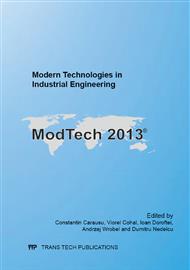p.128
p.135
p.141
p.147
p.152
p.158
p.164
p.170
p.175
Quality Oriented Self-Optimizing Control in Smart Machining Systems
Abstract:
In recent years, due to the hard competitiveness through globalization most manufacturing companies have focused on manufacturing higher value added products with low production costs. So, it is inevitable to apply the advanced technology to carry out it in effective and efficient way. Monitoring and control of machining processes are becoming increasingly important for keeping a consistent quality of machined parts. The paper presents in-process sensing and control techniques with applying information science for the next generation of quality control that eliminates the need for expensive post-process inspection. In this research, a machining process of machine tool is considered in terms of a quality oriented control. The self-optimizing control is proposed for enabling intelligent process monitoring and control which can detect the cutting conditions and status of machining operations. To prove the proposed self-optimizing control system, self-monitoring and self-adjusting, the machining process related to the tool condition such as tool wear was considered in this paper. The most crucial and determining factor to successful maximization of the manufacturing processes in any typical metal cutting process is tool wear. The evolutionary algorithm was developed to diagnose the tool wear. If the amount of tool wear is out of the allowed limit, the new cutting parameters should be generated and adjusted autonomously according to affecting the quality of the machined part through the tool wear.
Info:
Periodical:
Pages:
152-157
Citation:
Online since:
November 2013
Authors:
Price:
Сopyright:
© 2014 Trans Tech Publications Ltd. All Rights Reserved
Share:
Citation:


